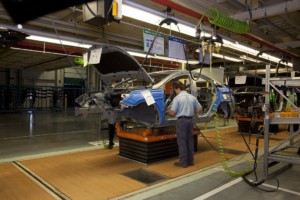 As part of my grand tour of German automotive, I visited the BMW plant in Leipzig. As of now, this is my second most favorite German automotive plant, after BMW in Munich. I will talk more about this quite well-organized and indeed beautiful plant in a later post series, but in this post I’m going to explain their very interesting and novel way to set up their assembly line. They call this the finger structure or comb structure (Fingerstruktur or Kammstruktur) because the line layout looks like the fingers of a hand or the teeth of a comb. I found this approach quite unique, and hence would like to share it with you.
As part of my grand tour of German automotive, I visited the BMW plant in Leipzig. As of now, this is my second most favorite German automotive plant, after BMW in Munich. I will talk more about this quite well-organized and indeed beautiful plant in a later post series, but in this post I’m going to explain their very interesting and novel way to set up their assembly line. They call this the finger structure or comb structure (Fingerstruktur or Kammstruktur) because the line layout looks like the fingers of a hand or the teeth of a comb. I found this approach quite unique, and hence would like to share it with you.
Flexibility
Variable Takt at Fendt in Marktoberdorf—Part 2
 In my previous post I started to show you how Fendt uses the distance between tractors on their assembly line to manage their quite high variability. By changing the distance between parts on the line, you can adjust the takt time for each part on the assembly line, hence the name Variable Takt. But this still leaves a lot of variability, as not all stations will have the same identical workload. In this and the next post I will go deeper into how Fendt manages its variability. This will be good, since Fendt is one of the benchmark plants in the world in handling variability.
In my previous post I started to show you how Fendt uses the distance between tractors on their assembly line to manage their quite high variability. By changing the distance between parts on the line, you can adjust the takt time for each part on the assembly line, hence the name Variable Takt. But this still leaves a lot of variability, as not all stations will have the same identical workload. In this and the next post I will go deeper into how Fendt manages its variability. This will be good, since Fendt is one of the benchmark plants in the world in handling variability.
Variable Takt at Fendt in Marktoberdorf—Part 1
 In this post I will look at how the tractor maker Fendt handles variability in its plant in Marktoberdorf, Germany. In my view, Fendt is one of the benchmark plants in the world in handling variability. In my previous post I looked at reasons why you may (or may not) leave one part empty on an assembly line with a part normally at every fixed interval. In this post I would like to expand on the idea of playing with the distance between parts to handle such variations in the cycle time, but with a focus on assembly lines where the interval between products can vary. We will look at how Fendt uses this to wrangle its variability.
In this post I will look at how the tractor maker Fendt handles variability in its plant in Marktoberdorf, Germany. In my view, Fendt is one of the benchmark plants in the world in handling variability. In my previous post I looked at reasons why you may (or may not) leave one part empty on an assembly line with a part normally at every fixed interval. In this post I would like to expand on the idea of playing with the distance between parts to handle such variations in the cycle time, but with a focus on assembly lines where the interval between products can vary. We will look at how Fendt uses this to wrangle its variability.
Using Empty Slots on the Assembly Line
 Normally, assembly lines are run with a product in every slot of the line. However, for various reasons, sometimes you may have an empty spot. Depending on your assembly line, you may even play with the general distance between products on the line. The latter is called variable takt, or VarioTakt. In this post I will explain about empty slots on the assembly line, and in the next post I will explain VarioTakt in more detail.
Normally, assembly lines are run with a product in every slot of the line. However, for various reasons, sometimes you may have an empty spot. Depending on your assembly line, you may even play with the general distance between products on the line. The latter is called variable takt, or VarioTakt. In this post I will explain about empty slots on the assembly line, and in the next post I will explain VarioTakt in more detail.
Keep Calm and Stop the Line—Part 2
 In manufacturing, a common sentiment is that the line (or generally the process) must run. There is some truth to that, but—counterintuitively—for a system to run well you need to know when to stop it too. This is my second post in a series giving you an overview on when it may be better to stop the line rather than keeping it running (and making everything worse). Keep on reading!
In manufacturing, a common sentiment is that the line (or generally the process) must run. There is some truth to that, but—counterintuitively—for a system to run well you need to know when to stop it too. This is my second post in a series giving you an overview on when it may be better to stop the line rather than keeping it running (and making everything worse). Keep on reading!
Flexible Multi-Model Assembly Line at Toyota
 The flexible assembly line at Toyota is a well-known manufacturing approach. Such a flexibility gives Toyota the ability to produce different models in almost any sequence. These lines were already common at Toyota around 1990, and by now they are found at many car makers. Time to take a look at how it is done and why it is good.
The flexible assembly line at Toyota is a well-known manufacturing approach. Such a flexibility gives Toyota the ability to produce different models in almost any sequence. These lines were already common at Toyota around 1990, and by now they are found at many car makers. Time to take a look at how it is done and why it is good.
